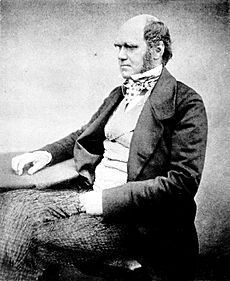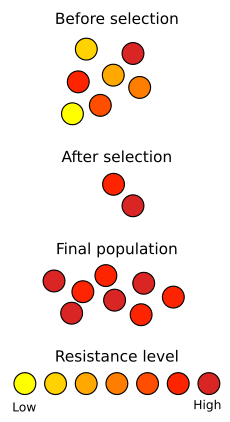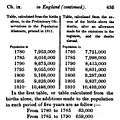Natural selection facts for kids

Natural selection is a central concept of evolution. It was an idea of Charles Darwin and Alfred Russel Wallace, and is sometimes called the survival of the fittest. Darwin chose the name as an analogy with artificial selection (selective breeding).
Natural selection is the process where organisms with favourable traits are more likely to reproduce. In doing so, they pass on these traits to the next generation. Over time this process allows organisms to adapt to their environment. This is because the frequency of genes for favourable traits increases in the population.
Members of a species are not all alike, partly because of differences in heredity (genetics). This is true even with children of the same parents. Some of these differences might make one organism better at surviving and reproducing than others in a particular habitat. When this organism reproduces, it passes along the genes, which gave it the advantage, to its children. Some adaptations are extremely long-lasting, useful in many habitats. The evolution of wings in birds is an example. Others are good only as long as the environment stays the same. If the environment changes enough, then another organism might do better.
The process
Natural selection explains why living organisms change over time to have the anatomy, the functions and behaviour that they have. It works like this:
- All living things have such fertility that their population size could increase rapidly forever.
- Actually, the size of populations does not increase to this extent. Mostly, numbers remain about the same.
- Food and other resources are limited. So, there is competition for food and resources.
- No two individuals are alike. Therefore, they do not have the same chance to live and reproduce.
- Much of this variation is inherited. The parents pass the traits to the children through their genes.
- The next generation comes from those that survive and reproduce. The elimination is caused by the relative fit between the individuals and the environment they live in. After many generations, the population has more helpful genetic differences, and fewer harmful ones. Natural selection is really a process of elimination.
Examples
There are now quite a number of examples of natural selection in natural populations.
Antibiotic resistance
A well-known example of natural selection in action is the development of antibiotic resistance in microorganisms. Since the discovery of penicillin in 1928 by Alexander Fleming, antibiotics have been used to fight bacterial diseases. Natural populations of bacteria contain, among their vast numbers of individual members, considerable variation in their genetic material, as the result of mutations. When exposed to antibiotics, most bacteria die quickly, but some have mutations that make them slightly less susceptible. If the exposure to antibiotics is short, these individuals will survive the treatment. The elimination of individuals which have no resistance is an example of natural selection.
Given enough time, and repeated exposure to the antibiotic, a population of antibiotic-resistant bacteria will emerge. This leads to what is known as an evolutionary arms race, or co-evolution, in which bacteria continue to develop strains that are less susceptible to antibiotics, while medical researchers continue to develop new antibiotics that can kill them. Response strategies typically include the use of different, stronger antibiotics; however, new strains of MRSA have recently emerged that are resistant even to these drugs. A similar situation occurs with pesticide resistance in plants and insects, and with malarial resistance to quinine.
Camouflage
One famous case study is the study of peppered moth evolution, and there are many other examples. Most of these day-flying moths were light in colour, but just a few of the moths were dark. At first, the light coloured moths survived better because they were camouflaged against the light colour of the nearby trees. This made it hard for birds to see them.
When factories were built, the pollution made all the trees look black. Now the light coloured moths were obvious against the dark bark. The dark coloured moths had the advantage after the environment changed. The genes controlling dark colour spread through the population of moths. After the second world war, controls against pollution worked to make the environment cleaner. Then the lighter moths once again had the advantage, and are now much more common.
Mimicry
Another example: Some harmless insects mimic other insects which are dangerous, or which taste foul. Mimicry evolves because the better mimics survive better. They live to produce more offspring than the less good mimics. The genes of the better mimics become more common in the species. Over time, mimic species get closer to their models. This is the process of evolution by natural selection.
Images for kids
-
Aristotle considered whether different forms could have appeared, only the useful ones surviving.
-
Part of Thomas Malthus's table of population growth in England 1780–1810, from his Essay on the Principle of Population, 6th edition, 1826
-
Charles Darwin noted that pigeon fanciers had created many kinds of pigeon, such as Tumblers (1, 12), Fantails (13), and Pouters (14) by selective breeding.
-
The peacock's elaborate plumage is mentioned by Darwin as an example of sexual selection, and is a classic example of Fisherian runaway, driven to its conspicuous size and coloration through mate choice by females over many generations.
See also
 In Spanish: Selección natural para niños
In Spanish: Selección natural para niños






